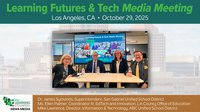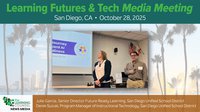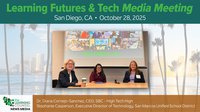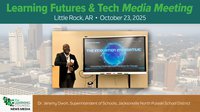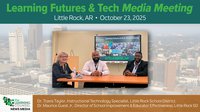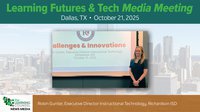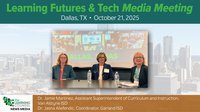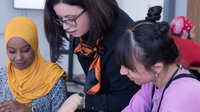Despite the last few years’ conversations about the need to transform K-12 learning, we remain stuck in familiar, dated questions associated with school and district silos. Current organizational structures in K-12 districts are designed for progressive adaptation when what we need is radical rethinking to create systemic and transformational change that will help us prepare students for the new demands of the future. It might be helpful for us to approach this conversation with a systems thinking mindset—a more suitable framework for critical and creative thinking to solve problems under the new century’s paradigms.
In The Search for Leadership: An Organisational Perspective, William Tate defines systems thinking as a management discipline that helps us understand organizational capacity and limitations by examining the interactions between the components of the system. A systems thinking organization is aware of feedback processes, underlining patterns of behavior, the relationships between the parts, recognition of delays and their impact, an understanding of the boundaries of mental and formal models, and the impact of alignment or the lack of it (Arnold, 2015).
Without systems thinking to design learning environments, data exchange and collaboration within districts, individual efforts can waste tens of thousands of dollars, depending on the size of the organization. Teachers can’t share their lesson plans efficiently; learning resources are tagged to learning standards in multiple programs and formats, remaining hidden or difficult to find; and student data is not accessible or useful to inform instruction. This results in lost opportunities for peer review and collaboration as well as a reduction in the quality of instruction.
Here’s a list of problems that arise without systems thinking in place:
- Well-intentioned educators select and adopt Apps and learning programs without fully understanding the technology integration and interoperability considerations.
- Alternatively, the tech team selects a solution without content or pedagogical expert input, resulting in technology that “works” but does not address intended outcomes.
- There is a lack of definition and understanding of how digital resources can be useful. For example, which tools can save teachers’ time, support standard-aligned resources, promote collaboration for learning, encourage student productivity, provide formative data and options to re-learn, support credit-recovery or enhance communication?
- Districts invest in costly professional development programs to use technologies which do not support the intended teaching methods.
- Student usage and data is exposed, resulting in privacy, security, and safety risks.
- A district does not have embedded digital literacy in the curriculum or intellectual property awareness programs, and lacks monitoring strategies.
- Learning data is not visible or transparent enough, and cannot be used to inform learning.
- Student grades and assessments remain scattered across dozens of apps and programs.
- Multiple logins and passwords create a logistical nightmare and result in the loss of precious learning hours; rostering and single sign-on are impossible to manage.
- Teacher-created content, resources, and plans cannot be efficiently reviewed, shared and meta-tagged.
The good news is that more schools and districts are finding success by explicitly applying a systems thinking approach to their unique challenges. Systems thinking calls for strong leadership at the top, and situational leadership in the bottom and middle (people lead from wherever they are in the organization). Faced with coherent organizational leadership and practices, vendors are forced to be more responsive and accountable for delivering exactly what districts need. So, how do we know if our school or district is designing and implementing solutions by using a systems thinking approach?
- The Vision — A district without a vision is like a ship without a rudder. Without a shared vision to inspire and guide, it is impossible to test, implement, scale, and sustain. The vision is strongest when it comes from both the top-down and the bottom-up.
- The “three-legged-stool” — Tight collaboration between school leadership, technology, and central office academic expertise is critical to implement competent and sustainable learning solutions at scale.
- A change management strategy — A district sets up to implement transformational programs with clear goals, achievable and measurable outcomes, and responsible parties to deliver each one on time. Stakeholder teams analyze and understand which processes need to be modified to make room for collaborative practices; identify thoughtful strategies to repurpose the talent and avoid alienating teams; and design and implement a communication plan to ensure the alignment and commitment of all stakeholders.
- Opportunities for professional development and growth, along with revised staff evaluation expectations — Districts that practice systems thinking recognize and support teachers’ knowledge, talent and skills by giving them voice and choice in professional development options and by aligning teacher evaluations to embrace a cycle of continuous improvement.
Start at the Beginning
We need to know where we are to create a roadmap that helps us get to where we want to go. Begin by developing a common vocabulary, so that all stakeholders are working with the same definitions. Perform an assessment or gap analysis to identify problems and challenges that need resolution. Follow that with a series of meetings with academic, technology, and school and district leaders to discuss learning models that better address the students’ needs. Notice that districts might need to articulate more than one model. Collaborate to define and clarify the types of technology tools that will best support your choices. Finally, evaluate and re-design on an ongoing basis to keep up with needs and changes.
Districts with a vision, strategies and plans in place are more likely to build a cohesive and effective learning ecosystem that maximizes everyone’s potential, safely gathers meaningful data to inform learning, and empowers students.
L. Beatriz Arnillas MFA, SPHR, is the former director of educational technology at the Houston Independent School District and senior education advisor to itslearning, Inc.
Sources
[1] Tate, William. The Search for Leadership: An Organisational Perspective, Triarchy Press. 2009. Quoted in Systemic Leadership Institute. “Principles of Systems Thinking as Applied to Management and Leadership”. https://www.systemicleadershipinstitute.org/basic-principles-of-systems-thinking-as-applied-to-management-and-leadership/. Date accessed: Oct. 1, 2018
[1] Arnold, Ross D. & Wade, Jon P. “A definition of Systems Thinking: A Systems Approach”. 2015 Conference on Systems Engineering Research. Stevens Institute, Castle Point on Hudson, Hoboken, NJ 07030. Retrieved from: ScienceDirect.com. September 28, 2018.




